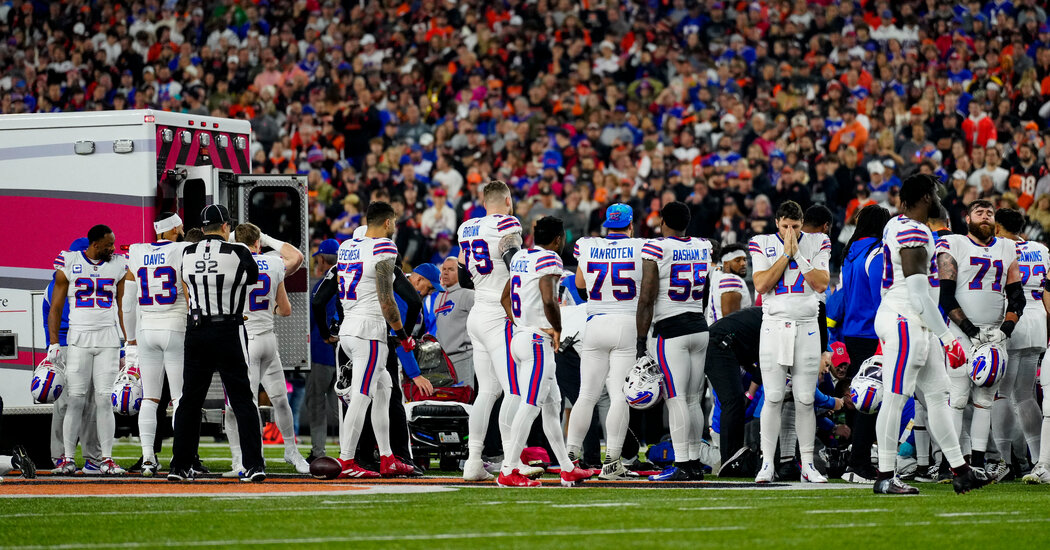It was 8:55 p.m., the early stages of a much-anticipated National Football League game, when it seemed as if a commonplace injury had interrupted the game.
“Another Bills player knocked out,” said ESPN “Monday Night Football” announcer Joe Buck, who wasn’t quite sure who was on the ground yet.
Mr. Buck soon realized that the situation was much more dire. A replay showed that the Buffalo player, Damar Hamlin, stood up momentarily after the tackle and then collapsed, his body remaining motionless.
“We’ve all seen players go down,” Mr Buck said in an interview on Tuesday. “We’ve seen players get up and then go down again. But it was shocking to see him fall after he got up.”
Within minutes, ESPN transformed from a broadcaster of a football game to a centerpiece of a major and unexpected breaking news event. The question everyone wanted to know, including the sports network: What had happened to Mr. Hamlin and would he be okay?
Several hours later, the Bills announced that Mr. Hamlin, 24, had gone into cardiac arrest after tackling a Cincinnati Bengals receiver. On Tuesday, the team said he was in critical condition in the intensive care unit of a Cincinnati hospital.
But in those early minutes, with millions of viewers and little information available, Mr. Buck had to try and explain a possible life-or-death situation live on TV. He saw that things had taken a terrible turn and that medical personnel were suddenly resuscitating Mr. Hamlin. But Mr. Buck didn’t know much more than that.
“It was a nightmare,” he said. “It was certainly nothing anyone is ever prepared for. You have all that hype and build up and everyone can’t wait to see this matchup, and in the snap of a finger it’s completely different. Football just goes out the window.”
For the next few hours, ESPN’s coverage of Mr. Hamlin bounced to and from the broadcast booth, the field at the Bengals stadium, a nearby hospital, and studios in New York and Washington. On Monday night, ESPN suddenly looked like an episode of “Nightline” or a late hour on CNN, during a major news report.
The network was careful: there were few reruns; there was little speculation about Mr. Hamlin’s health. Lisa Salters, the “Monday Night Football” sideline reporter, recounted only what she’d seen: the Bills and Bengals coaches meeting and talking, players going in and out of locker rooms.
Not long after Mr. Hamlin collapsed, Mr. Buck pointed out that the players on the field had been told they had five minutes to warm up and prepare to play again. ESPN’s footage showed Bengals quarterback Joe Burrow making pitches. In a late-night press conference, the NFL denied it had considered restarting the game.
Mr. Buck said the five-minute warmup information came from John Parry, ESPN’s NFL analyst, “who is in an open line of communication with the league’s New York office.”
“It’s our duty to provide the information we get from the NFL in real time as soon as we get it,” Buck said. “That is our job at the moment. That’s all we can deal with.”
On Tuesday afternoon, the network said it was in constant contact with the league and that “we were reporting what we were told at the time”.
“This was an unprecedented, rapidly evolving circumstance,” the network continued. “All night long we refrained from speculation.”
About an hour after Mr. Hamlin fell to the ground, “SportsCenter” anchor Scott Van Pelt took over coverage from a Washington studio, where analyst Ryan Clark, a former NFL player, joined him. From there, Mr. Van Pelt interviewed reporters who were in the hospital, as well as Mrs. Salters from the field and Mr. Buck from the booth.
ESPN’s coverage showed the benefits of a newsroom and analysts it can deploy when there’s a stunning turn of events. The NFL is starting to make deals with tech companies — YouTube just got the league’s Sunday Ticket package and Amazon has “Thursday Night Football” — who don’t have those resources to fall back on.
In the broadcast booth, Mr. Buck received text messages from friends and family asking him what was happening on the field – maybe there was something he knew he couldn’t share on the air?
“I have absolutely no information,” Mr. Buck recalls saying. “All I can tell you is it’s serious and what I’m seeing is something I’ve never seen before.”

